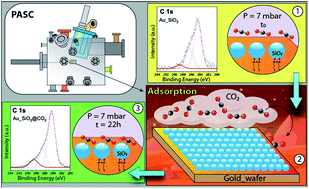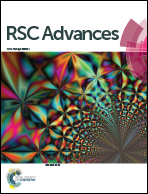2-D organization of silica nanoparticles on gold surfaces: CO2 marker detection and storage†
Abstract
A single layer of silica nanoparticles with an average size of ∼200 nm was deposited over the surface of pristine gold wafers, aided by (3-mercaptopropyl)trimethoxysilane. The nanoparticle immobilization was driven by covalent bonding rather than a self-assembly process, leading to a cluster-assembled material which has CO2 sensing features. Here, we show how this device can be used for CO2 physisorption and chemisorption. We analyse the device, both spectroscopically and morphologically, before and after exposure to an atmosphere of 7 mbar of CO2, inside a planetary atmospheres and surfaces simulation chamber, (PASC) mimiking Martian atmospheric conditions. Our studies demonstrate that these clusters are suitable for CO2 detection and storage, under well controlled experimental Martian conditions. Their high sensitivity at a very low concentration of CO2, 12.4 ppm, makes them ideal candidates in the nanosensor field.



 Please wait while we load your content...
Please wait while we load your content...